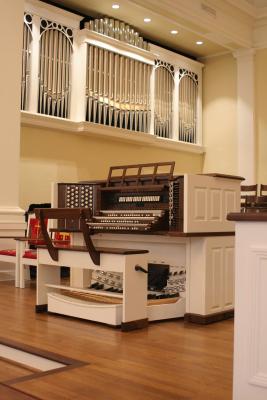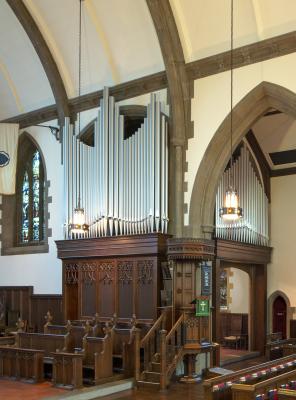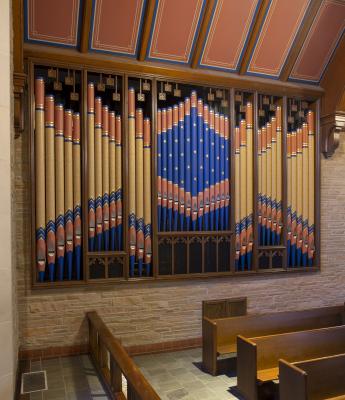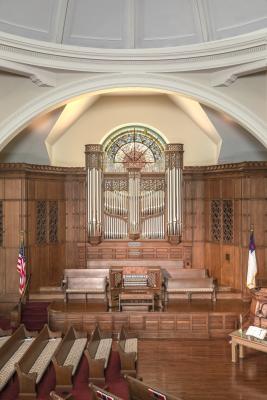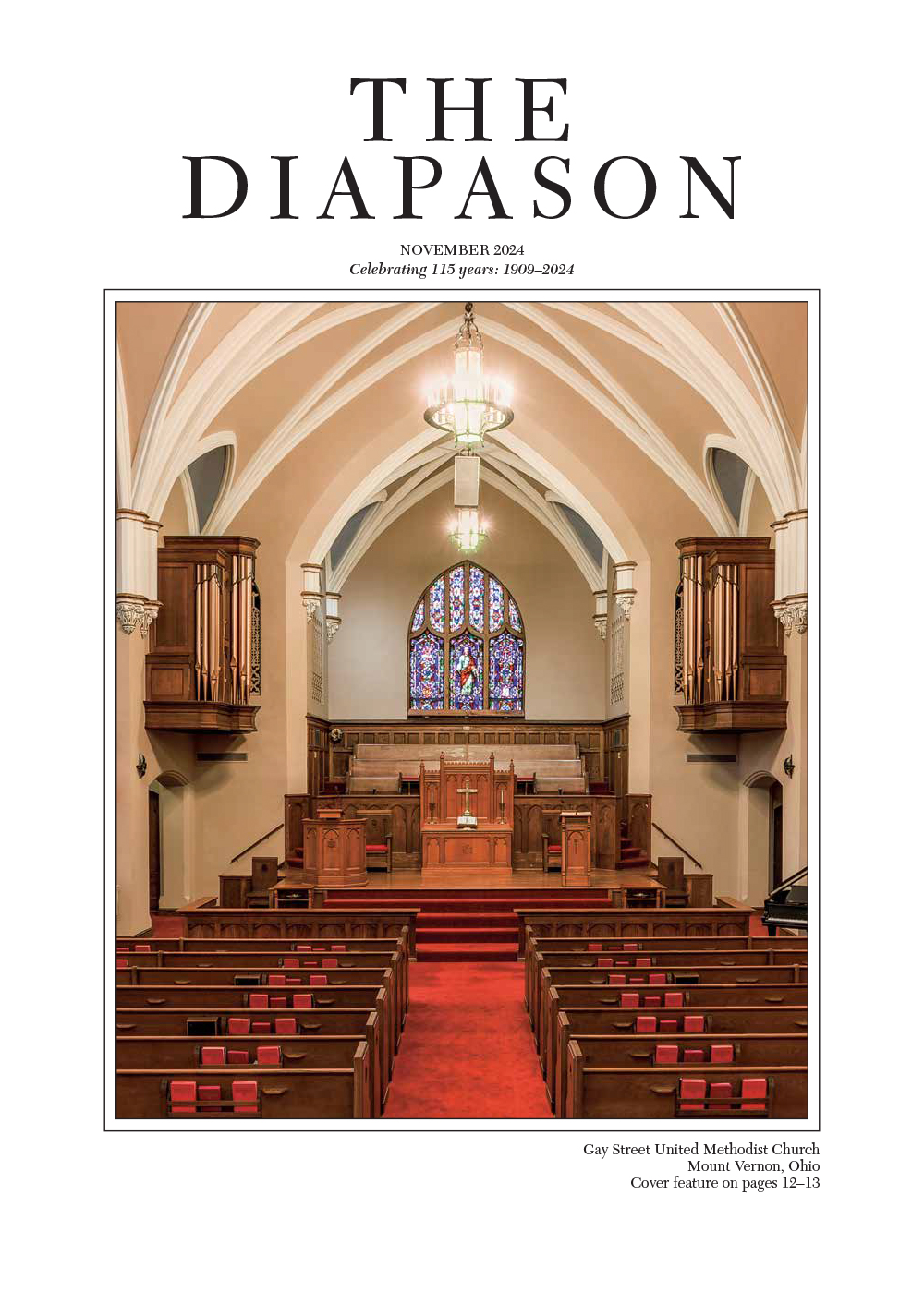Goulding & Wood Pipe Organ Builders, Indianapolis, Indiana, Fortieth Anniversary; Saint John’s Episcopal Cathedral, Knoxville, Tennessee, Opus 52
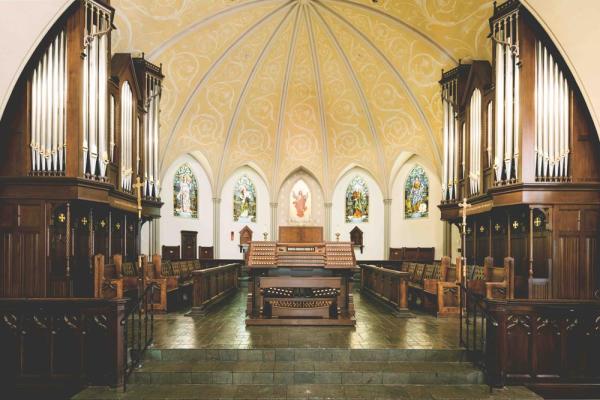
The year 2020 was indeed an historic year for many reasons. As the calendar page turns to another year, it has become somewhat easier to see in retrospect that 2020 contained reasons for celebration even amidst a time of pandemic and stress. For Goulding & Wood Pipe Organ Builders of Indianapolis, 2020 marked forty years of operation and afforded a chance to look back at the arc of the company’s history. The capstone of this anniversary year was the completion of the firm’s Opus 52 organ for Saint John’s Episcopal Cathedral of Knoxville, Tennessee. This project is built on a solid legacy of organ building from the Indianapolis workshop.
John Goulding and Thomas Wood joined forces in 1980, combining shared experiences at the E. H. Holloway Corporation and individual backgrounds with Gratian and Holtkamp organ companies on the part of Mr. Goulding and, for Mr. Wood, experience at Indiana University School of Music including participating in the creation of its first electronic music laboratory while also serving as curator of organs. While from very different backgrounds, both men shared a lifelong love of the organ, its music, and the ideals of corporate worship. They inherited a particular understanding of the organ reform movement, then in its full maturity, and Mr. Goulding’s mechanical innovations including a unique windchest design, tremolo action, and schwimmer wind regulators. These raw elements formed an impressively strong foundation for the new firm, and the company quickly built a reputation for excellence and sophistication.
Within the first six years of operation and first ten projects, the firm had expanded to the Chicago and Washington, D.C., metro areas. Installations in Durham, North Carolina, and Atlanta, Georgia, soon followed, establishing a trend toward a significant presence in the Southeast. In the years that followed, Mr. Goulding and Mr. Wood built a strong team of like-minded organ builders who shared a solid commitment to building electro-pneumatic-action organs with the artistry and refinement usually associated only with mechanical-action builders. Musically, this achievement flows in large part from the firm’s exclusive windchest design. As an electro-pneumatic slider and pallet windchest, it marries the time-honored benefits of common key channels with the flexibility of remote key action providing for movable consoles and flexible coupling and control systems. The efficiency and simplicity inherent in this system have long been recognized for their contribution to the long-term viability of an instrument. Slider chests have few working parts to wear out, and when the time for major maintenance comes, access and scope of work are optimum for easy restoration. One of the specific design considerations for Mr. Goulding was ease of long-term renewal, so that an institution will not be saddled with exorbitant costs typical of many refurbishment projects.
As the organ reform movement began to shed some of its excesses and musical taste returned to more substantial ideas of tonal architecture, Goulding & Wood integrated the lessons learned about chorus structure with the aurally based craving for generous fundamental and variety of color. Already by 1989, this marriage is seen fully developed in the layout of the organ for the Church of Saint John the Evangelist located on the other side of Indianapolis’s downtown from the Goulding & Wood workshop. The stoplist of this two-manual organ comprises a wealth of 8′ stops, a wide variety of reed colors, and a carefully balanced scheme of principal choruses that allows organists to create plenums of several different levels of dynamic volume and tonal intensity. This organ was in some ways a working out of tonal ideas that laid the groundwork for the much larger instruments in the Cathedral of Christ the King in Atlanta and Christ Church Cathedral in New Orleans. Brandon Woods, the firm’s voicer beginning with Opus 6 (1984), grew in his understanding of tonal structure and mastery of unifying the voice of each organ specifically for the acoustical environment in which it is placed. An assiduous student of past voicers, Mr. Woods relished restoring old pipework, particularly in the renovation projects the company undertook on instruments from many different builders and eras. He brought the lessons he learned from observing other voicers’ work to bear on his own treatment of pipes, both flue and reed. As the sole voicer, Mr. Woods exerted a strong bearing on the company’s musical personality.
John Goulding, who oversaw the design and construction of the organs, was joined by his son, Mark Goulding, in 1985. The younger Goulding began first as the head chest builder, laying out and fabricating the slider chests. In time, he began overseeing installation crews and general shop organization. As the company continued to build larger and more complex instruments, the workshop saw a growth in size and sophistication. The addition of Computer-Assisted-Design supported the increase in refinement of mechanical and visual designs notably present in the instruments in Saint Meinrad, Indiana, and Greenville, South Carolina.
By the beginning years of the present century, Goulding & Wood had attained a national reputation of excellence. The founders were ready to pass along creative control to a new generation with the assurance that the company would continue to expand and develop along the trajectory they had established. In 2003 John Goulding and Thomas Wood retired, making the unusual decision to turn ownership of the company completely over to active members of the organ building team. The first project completed following this transition was the sixty-nine-rank organ for Preston Hollow Presbyterian Church in Dallas, Texas, an instrument that boasts two 32′ stops, four independent full-length open 16′ flue ranks, and extensive carved casework in the Georgian neo-classical style.
Prestigious projects followed, including installations at Ball State University in Indiana and Loyola University of Chicago. No less significant to the company’s development, organs in Germantown, Tennessee, Macon, Georgia, and Lexington, Kentucky, maintained the company’s evolution toward a tonal ideal that favors choruses based on rich fundamental tone, a wide palette of vibrant colors, and a seamless blend building to a thrilling tutti. Goulding & Wood continued to go from strength to strength, earning acclaim for each subsequent instrument. As a natural part of this evolution, the company attracted and trained young talent. Several woodworkers came from the Indiana University Herron School of Art and Design, and these young artists have discovered a newfound passion for the pipe organ. Organists also found their way into the shop, enriching the conversations about tonal design and musical goals for each project. The company suffered an unexpected and painful turn when Mr. Woods passed away in 2016 shortly after a cancer diagnosis. Fortunately, the voicing room was in good hands as tonal responsibilities passed to Jerin Kelly (a member of The Diapason’s 20 Under 30 Class of 2017), who had extensive background in woodworking and as a musician in his own right. Mr. Kelly has followed closely in the footsteps of Mr. Woods, excelling both at refurbishing pipework from other builders and placing his own stamp on new organs.
The Goulding & Wood team continues to pair veteran craftsmen, many with tenures at the firm of several decades in length, with a younger generation of artisans, eager to push the company further into the future. This combination of seasoned experience and fresh ideas continues to bear fruit in exciting ways. The results are manifest to an extraordinary degree in the organ for Saint John’s Episcopal Cathedral of Knoxville, Tennessee, the firm’s fifty-second opus-numbered project. A comprehensive tonal design that furnishes organists with abundant resources for service playing and faithful rendition of repertoire is housed within handsome cases adorning the church with a panoply of architectural detail. The ornate cabinetry, including a wealth of hand-carved detail, asserts a commanding presence that nevertheless complements the architecture rather than competes with it. Warm polished tin pipes with gilded mouths echo the brightness of the room, and bespoke features, such as the linen-fold panels, delight the eye. The beauty, in both sound and appearance, is built upon a mechanical layout that is as ingenious as it is elegant, ensuring not only uncompromised reliability but also access to every component.
The Knoxville organ is in many ways a summation of the learning, growth, and hard work that the company has seen over its forty-year history, yet it would be erroneous to think of it as a magnum opus. The artists of Goulding & Wood are continually expanding their vision to achieve ever more refinement in all aspects of organ building. As they look forward to the next forty years, the team is eager to approach each project with enthusiasm, professionalism, and excellence.
—Goulding & Wood Pipe Organ Builders
GREAT (Manual II)
16′ Violone 61 pipes
8′ First Diapason 61 pipes
8′ Second Diapason 61 pipes
8′ Violone (ext 16′) 12 pipes
8′ Harmonic Flute (1–12 Bdn) 49 pipes
8′ Bourdon 61 pipes
4′ Octave 61 pipes
4′ Open Flute 61 pipes
2-2⁄3′ Twelfth 61 pipes
2′ Fifteenth 61 pipes
1-3⁄5′ Seventeenth 61 pipes
1-1⁄3′ Fourniture IV 244 pipes
8′ Trumpet 61 pipes
8′ Festival Trumpet 56 pipes
8′ Tuba (Ch)
Tremulant
Chimes (digital, 37 notes)
SWELL (Manual III, enclosed)
16′ Gedeckt 61 pipes
8′ Geigen Diapason 61 pipes
8′ Gedeckt (ext 16′) 12 pipes
8′ Viole de Gambe 61 pipes
8′ Voix celeste (GG) 54 pipes
4′ Octave Geigen 61 pipes
4′ Traverse Flute 61 pipes
2′ Octave 61 pipes
2′ Piccolo 61 pipes
2′ Mixture III–IV 223 pipes
16′ Bassoon-Oboe 61 pipes
8′ Trumpet 61 pipes
8′ Oboe (ext 16′) 12 pipes
8′ Vox Humana 61 pipes
4′ Clarion 61 pipes
8′ Festival Trumpet (Gt)
8′ Tuba (Ch)
Tremulant
CHOIR (Manual I, enclosed)
16′ Dulciana (ext 8′) 12 pipes
8′ Open Diapason 61 pipes
8′ Second Diapason (Gt)
8′ Chimney Flute 61 pipes
8′ Dulciana 61 pipes
8′ Unda Maris (TC) 49 pipes
4′ Principal 61 pipes
4′ Spindle Flute 61 pipes
2-2⁄3′ Nazard 61 pipes
2′ Octave 61 pipes
2′ Recorder 61 pipes
1-3⁄5′ Tierce 61 pipes
1-1⁄3′ Larigot 61 pipes
1′ Cymbale III 183 pipes
8′ Clarinet 61 pipes
8′ Tuba 61 pipes
8′ Festival Trumpet (Gt)
Tremulant
Cymbelstern (5 tuned bells)
Nightingale (2 pipes in water)
ANTIPHONAL
8′ Echo Diapason 61 pipes
8′ Diapason Celeste 61 pipes
8′ Stopped Diapason 61 pipes
4′ Octave 61 pipes
4′ Spire Flute 61 pipes
2′ Fifteenth 61 pipes
1-1⁄3′ Mixture II–III 171 pipes
PEDAL
32′ Violone (digital ext) 12 notes
32′ Bourdon (digital ext) 12 notes
16′ Principal 32 pipes
16′ Bourdon 32 pipes
16′ Violone (Gt)
16′ Gedeckt (Sw)
16′ Dulciana (Ch)
8′ Octave 32 pipes
8′ Stopped Flute 32 pipes
8′ Violone (Gt)
8′ Gedeckt (Sw)
4′ Fifteenth 32 pipes
4′ Cantus Flute 32 pipes
2-2⁄3′ Fourniture IV 128 pipes
32′ Contra Bassoon (digital ext) 12 notes
16′ Trombone 32 pipes
16′ Bassoon (Sw)
8′ Tromba 32 pipes
8′ Bassoon (Sw)
4′ Clarion 32 pipes
8′ Tuba (Ch)
Tremulant
ANTIPHONAL PEDAL
16′ Stopped Diapason (ext) 12 pipes
8′ Stopped Diapason (fr Ant 8′)
Normal complement of couplers
Three manuals, 70 ranks, 3,884 pipes
Photo caption: Saint John’s Episcopal Cathedral, Knoxville, Tennessee (photo credit: Ben Finch)
See the video of the Saint John’s Episcopal Cathedral, Knoxville, Tennessee, organ:
https://www.youtube.com/watch?v=DHVZxHGWpCQ&feature=youtu.be

